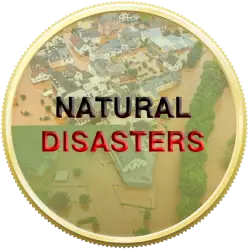NATURAL DISASTERS ( DISA )

Natural Disasters (DISA) is a memecoin about the natural disasters that plague the planet.
Distribution start
Saturday, June 15, 2024, 12:59 PM
Introduction
Funny Meme Coins energizes the meme community by bringing together the best of memecoins. Natural Disasters (DISA) is a memecoin about the natural disasters that plague the planet.
The memecoin DISA embodies the message ‘Natural Disasters’. The Funny Meme Coins community builds a solid foundation of recognition and enthusiastic support that fuels its potential for success.
While no two disasters are the same, we can do more today to enhance preparedness, reduce impacts, and support resilient recovery. Key actions can make a significant difference for the people and communities at the heart of natural disasters.
The poorer a community is, the more vulnerable it becomes to natural risks and climate change. Today, disasters push 26 million people into poverty every year. For farming families with limited savings, a flood or drought that destroys crops is economically devastating. This occurs both in the short term—with loss of income reducing access to food and other necessities—and in the long term, as the impacts on education and health limit children’s prospects throughout their lives.
Inclusive development and poverty reduction are essential to protect the poor from disasters. Improving access to financial, technical, and institutional resources will make them better equipped to respond to climate change. In fact, developmental progress could halve the number of people climate change will push into poverty by 2030.
Adaptation is a challenge for families and small businesses that drive local economies in developing nations. They have incentives to adapt—families and entrepreneurs understand what climate disruptions mean for supplies, customers, and outcomes. However, they need support to prepare, guidance on investments, and financing, especially when solutions have high initial costs.
Enhancing Preparedness and Resilience
Increasing resilience involves several key strategies:
- Early Warning Systems: Implementing advanced early warning systems can provide crucial time for communities to evacuate and protect their assets. These systems should be accessible to even the most remote areas.
- Education and Training: Educating communities about disaster preparedness and response can significantly reduce the impact of natural disasters. Training programs should focus on local needs and be inclusive of all community members.
- Infrastructure Development: Investing in resilient infrastructure, such as flood defenses, storm shelters, and climate-resilient buildings, can mitigate the damage caused by natural disasters.
- Community Engagement: Engaging communities in disaster planning ensures that the strategies implemented are practical and effective. Local knowledge and participation are crucial for the success of disaster risk reduction initiatives.
Reducing Impacts
Mitigating the impact of disasters involves:
- Sustainable Agriculture Practices: Promoting sustainable agricultural practices can help farming communities withstand climate shocks. Techniques such as crop diversification and improved irrigation systems are vital.
- Social Protection Programs: Establishing robust social protection programs, including insurance schemes and emergency funds, can provide a safety net for vulnerable populations.
- Environmental Conservation: Protecting and restoring natural ecosystems like mangroves, wetlands, and forests can act as natural barriers against disasters and help in carbon sequestration.
Supporting Resilient Recovery
Post-disaster recovery should focus on building back better:
- Financial Support: Providing financial support to affected families and businesses can help them rebuild more resiliently. This includes grants, low-interest loans, and subsidies for resilient construction.
- Psychosocial Support: Addressing the psychological impact of disasters is essential for community recovery. Providing mental health services and support networks can aid in the healing process.
- Policy and Governance: Strong policies and governance frameworks are necessary to ensure that recovery efforts are coordinated and effective. Governments must prioritize disaster risk reduction in their development agendas.
By taking these actions, we can create communities that are not only better prepared for natural disasters but also capable of thriving despite the challenges posed by climate change.
TOKENOMICS
DISA memecoin is listed on Decentralized Exchange (Ethereum network). 96.5358% FunPool.
Transaction fees are low and attract more investors and make DISA memecoin a form of negotiation uncomplicated.
TOTAL SUPPLY
1,000,000,000
DISTRIBUTION & UTILITIES
DISA memecoin will not be distributed in pre-sale so that every investor has the chance to participate.
DISA memecoin has no specific use, but can be traded on a decentralized exchange. It is not intended for be used as a means of payment or as a store of value.
ROADMAP
Phase 1: Meme
Phase 2: Vibe and HODL
Phase 3: Meme Takeover

